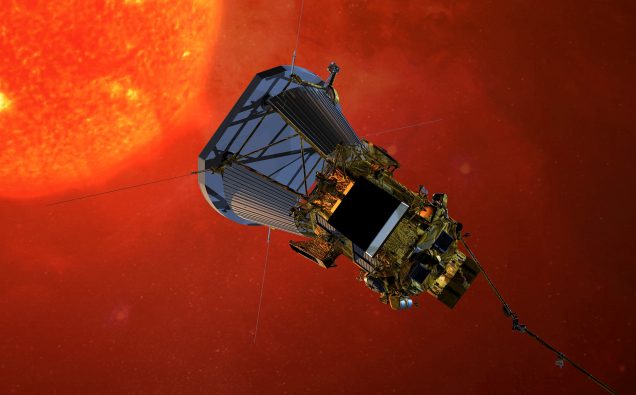
Artist’s impression of NASA’s Parker Solar Probe spacecraft on approach to the Sun Photo: NASA/Johns Hopkins University Applied Physics Laboratory/Wikimedia Commons
Marking first ever visit to a star, NASA’s Parker Solar Probe will launch during a 20-day window that opens July 31, 2018, a space travel that would help answer some of the longstanding puzzles about the Sun and its powerful solar winds.
“The solar probe is going to a region of space that has never been explored before. It’s very exciting that we’ll finally get a look,” says astrophysicist Eugene Parker, after whom the mission has been named.
“One would like to have some more detailed measurements of what’s going on in the solar wind. I’m sure that there will be some surprises. There always are,” the scientist said, according to a statement by Johns Hopkins University.
According to Planetary Society, the spacecraft weighs 685 kilograms fully fueled, and consists of an instrument deck and large carbon composite heat shield.
“The 11.5-centimeter-thick heat shield will protect Parker Solar Probe from the 1,700-Kelvin temperatures it will encounter during its coronal dives, keeping the bulk of the spacecraft at room temperature,” a description of the spacecraft by Planetary Society says.
So, what, actually will happen?
The NASA robotic spacecraft will not literally touch the sun’s core surface but it will get as closer as 3.9 million miles.
It has been designed to survive intense solar conditions near the Sun with the use of a solar shadow-shield.
The National Public Radio reports the NASA probe is expected to complete 24 orbits over the course of more than six years, “looping closer to the sun and eventually hurtling toward it at a speed of 450,000 miles per hour.”
It was way back in 1958, when Parker—then a young professor at the university’s Enrico Fermi Institute—published an article in the Astrophysical Journal called “Dynamics of the interplanetary gas and magnetic fields.”
Parker believed there was highly energized matter and radiation constantly escaping the sun, and that it affected the planets and space throughout our solar system, the University said.
Now known as the solar wind, the phenomenon, according to the University, has been proven to exist repeatedly through direct observation. “Parker’s work forms the basis for much of our understanding about how stars interact with the worlds that orbit them.”
“Parker Solar Probe is going to answer questions about solar physics that we’ve puzzled over for more than six decades,” said Parker Solar Probe Project Scientist Nicola Fox, of the Johns Hopkins University Applied Physics Laboratory.
“It’s a spacecraft loaded with technological breakthroughs that will solve many of the largest mysteries about our star, including finding out why the sun’s corona is so much hotter than its surface. And we’re very proud to be able to carry Gene’s name with us on this amazing voyage of discovery.”

















